How to Choose the Perfect Rug for Your Space
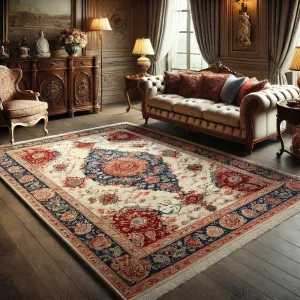
What better way to make the conversation area or living room aesthetically pleasing than Persian vintage rugs.
Finding the perfect rug for your home is more than just selecting a piece that looks good. The right rug can transform a space, providing warmth, enhancing the decor, and tying together different design elements. This comprehensive rug buyers guide will help you understand the essential factors to consider when purchasing a rug, ensuring you make the best choice for your space, including options for affordable rugs.
- Determining the Right Rug Size
Choosing the correct size is one of the most critical factors when buying a rug. The size of the rug should complement the layout and furniture arrangement of the room.
Living Room
- A standard 8×10-foot rug or larger works well for spacious living rooms.
- If placing a rug under a coffee table, ensure all front legs of sofas and chairs rest on the rug.
- For smaller living rooms, a 5×7-foot or 6×9-foot rug can create a cozy, defined space.
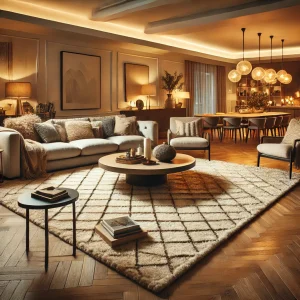
Your interior design will look fantastic with this great selection patterned rug. Flatweave rugs can change the whole space to a great resource.
Dining Room
- The rug should be large enough so that when chairs are pulled out, their back legs remain on the rug.
- An 8×10-foot or 9×12-foot rug is ideal for a table seating six to eight people.
Bedroom
- A large 9×12-foot rug fits best under a king-size bed, leaving room on the sides for foot comfort.
- Alternatively, use two 3×5-foot runners on either side of the bed for a budget-friendly option.
Hallways & Entryways
- Runner rugs (2.5-3 feet wide and 6-14 feet long) add warmth and function to hallways.
- In an entryway, use a 4×6-foot or 5×7-foot rug for a welcoming ambiance.
- Choosing the Right Material
Rug material affects durability, comfort, and maintenance. Here’s an overview of popular materials:
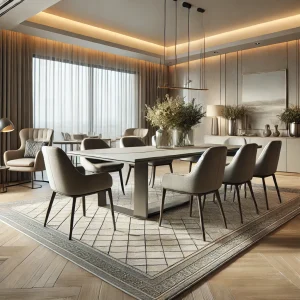
Interior design with a neutral rug. This durable rug with natural materials like wool is the best bet to cover your seating area.
Wool Rugs
- Pros: Naturally soft, durable, stain-resistant, and excellent at retaining warmth.
- Best for: Living rooms, bedrooms, and high-traffic areas.
Cotton Rugs
- Pros: Lightweight, affordable, easy to clean, and available in many patterns.
- Best for: Kitchens, casual living spaces, and children’s rooms.
Silk & Viscose Rugs
- Pros: Luxurious, soft texture with a stunning sheen.
- Cons: Delicate and requires professional cleaning.
- Best for: Low-traffic areas like bedrooms and formal spaces.
Jute & Sisal Rugs
- Pros: Eco-friendly, durable, and naturally textured.
- Cons: Can be rough underfoot and prone to staining.
- Best for: Entryways, coastal decor, and casual spaces.
Synthetic Rugs (Polypropylene, Nylon, Polyester)
- Pros: Affordable, stain-resistant, and easy to clean.
- Best for: Outdoor areas, kids’ rooms, and high-traffic zones.
- Rug Patterns & Colors
Selecting the right rug color and pattern can set the tone for your decor.
Color Selection Tips:
- Neutral Tones: Beige, gray, or ivory rugs create a timeless, versatile look.
- Bold Colors: Deep blues, reds, or greens can add character and contrast.
- Dark Rugs: Best for hiding stains and adding coziness.
- Light Rugs: Brighten up a room and create a sense of spaciousness.
Popular Patterns:
- Geometric: Contemporary and modern appeal.
- Floral: Perfect for traditional or vintage-inspired interiors.
- Oriental & Persian: Classic, elegant, and rich in heritage.
- Striped: Adds dimension and makes small spaces appear larger.
- Shape & Placement Considerations
Rectangular Rugs
- The most common shape, ideal for defining spaces.
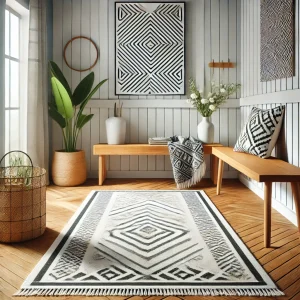
A new rug with a low pile from the entryway into the seating area looks great next to other elements especially furniture.
Round Rugs
- Best for creating a focal point under circular dining tables or in small spaces like nurseries.
Runner Rugs
- Perfect for hallways, kitchens, and bedside placements.
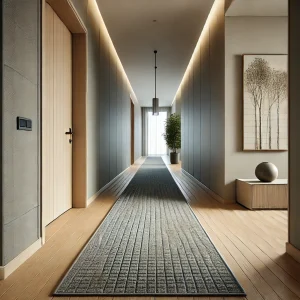
An area rug made of synthetic materials and short pile height is a good rug for hallways. Use two rugs for long halls if you have a smaller rug.
Layering Rugs
- Placing a smaller rug over a larger neutral base adds texture and warmth to a room.
- Rug Maintenance & Care
To maintain the beauty and longevity of your rug, follow these care tips:
Regular Cleaning
- Vacuum your rug weekly to remove dirt and debris.
- Use a rug pad to prevent slipping and extend its lifespan.
- Rotate the rug every 6 months for even wear.
Spot Cleaning & Stain Removal
- Blot spills immediately with a clean cloth—never rub.
- Use mild detergent mixed with water for spot cleaning.
- For tough stains, consult a professional rug cleaner.
Deep Cleaning & Storage
- Wool and silk rugs require professional cleaning every 1-2 years.
- When storing, roll the rug tightly and wrap it in a breathable fabric.
- Finding Quality Rugs & Shopping Tips
When purchasing a rug, keep these considerations in mind:
Handmade vs. Machine-Made Rugs
- Handmade Rugs: Higher quality, unique craftsmanship, and increased value.
- Machine-Made Rugs: More affordable, mass-produced, and lower durability.
Return & Warranty Policies
- Choose retailers that offer a trial period or return option.
- Always check for manufacturer warranties, especially for high-end rugs.
Where to Buy Rugs
- Online Retailers: Wayfair, Rugs.com, Overstock, and Amazon offer vast selections.
- Local Rug Shops: Great for seeing rugs in person before purchase.
- Custom Rug Designers: Ideal for unique, one-of-a-kind pieces.
- Final Thoughts: Choosing the Perfect Rug
A carefully chosen rug enhances both function and aesthetic appeal in your home. By considering size, material, color, and maintenance, you can find a rug that fits perfectly into your lifestyle and space. Whether you prefer a traditional Persian rug, a modern geometric design, or a cozy wool piece, the right rug can elevate your home’s style effortlessly.
Understanding Your Space
Before selecting a rug, it’s essential to understand the space where it will be placed. Consider the room’s purpose, size, and style. For instance, a dining room rug should be durable and easy to clean, as it will likely face spills and heavy foot traffic. On the other hand, a bedroom rug can be softer and more luxurious, providing a cozy feel underfoot.
Take note of the natural light in the room, as it can affect the color and texture of the rug. A rug that looks vibrant in a well-lit room might appear dull in a dimly lit space. Understanding these factors will help you choose a rug that not only fits your aesthetic but also meets the practical needs of the room.
Measuring Your Space
Measuring the room and the area where the rug will be placed is crucial to ensure the right size. Use a tape measure to record the dimensions of the room, including the location of doors, windows, and any obstructions. Consider the size and shape of the furniture and how it will be arranged in the room.
For a dining room, measure the length and width of the dining table and chairs to determine the ideal rug size. Ensure that the rug extends at least 24 inches beyond the edges of the dining table to accommodate pulled-out chairs. Accurate measurements will help you avoid purchasing a rug that is too small or too large for the space.
Choosing the Right Size
Choosing the right size rug can make or break the look of a room. A rug that is too small can make the area look chopped up and accidental, while a rug that is too large can overwhelm the space. Consider the “Goldilocks rule” – the rug should fit, not be too big or too small.
For a living room, a rug that is at least 8 inches larger on all sides than the furniture is a good rule of thumb. This ensures that all furniture legs rest comfortably on the rug, creating a cohesive look. For a dining room, a rug that is at least 12 inches larger on all sides than the dining table is recommended. This allows enough space for chairs to be pulled out without falling off the rug, maintaining a balanced and polished appearance.
Selecting the Perfect Material
The material of the rug can greatly impact its durability and maintenance. Natural fibers like wool and silk are durable and long-lasting, but can be more expensive. Wool rugs, for example, are naturally stain-resistant and excellent at retaining warmth, making them ideal for living rooms and bedrooms.
Synthetic fibers like nylon and polyester are affordable and easy to clean, but may not be as durable. These materials are perfect for high-traffic areas like kids’ rooms or outdoor spaces. Consider the lifestyle and priorities of the user when selecting the material. For example, a family with young children may prefer a durable and stain-resistant rug, while a couple with no pets may prefer a luxurious and soft rug.
Considering Pile and Texture
The pile and texture of the rug can greatly impact its look and feel. A low-pile rug is ideal for high-traffic areas, as it is easier to clean and less likely to show wear. These rugs are perfect for entryways, hallways, and dining rooms where durability is key. On the other hand, a high-pile rug is better suited for low-traffic areas like bedrooms or living rooms, where comfort and warmth are more important.
Consider the texture of the rug and how it will feel underfoot. A rug with a soft and plush texture can add warmth and comfort to a room, while a rug with a rough and scratchy texture can be uncomfortable. Choose a texture that complements the room’s function and enhances its overall aesthetic.
Adding a Neutral Touch
A neutral-colored rug can add a touch of sophistication and elegance to a room. Consider a rug with a neutral color palette, such as beige, gray, or taupe. A neutral rug can also help to balance out bold and bright colors in the room. For example, a neutral rug can help to ground a bold-colored sofa or armchair, creating a harmonious look.
Additionally, a neutral rug can make it easier to change up the decor in the room without having to replace the rug. This versatility makes neutral rugs a practical and stylish choice for any space. Whether you’re looking to create a calm and serene environment or a chic and modern look, a neutral rug can be the perfect finishing touch.



Leave a Reply
You must be logged in to post a comment.